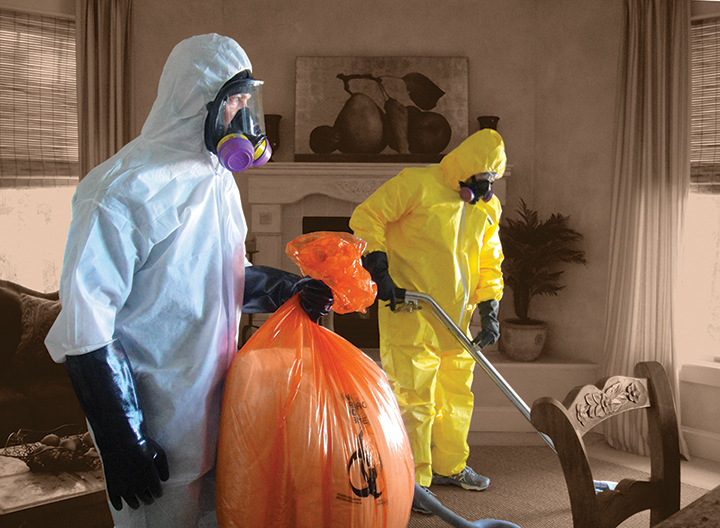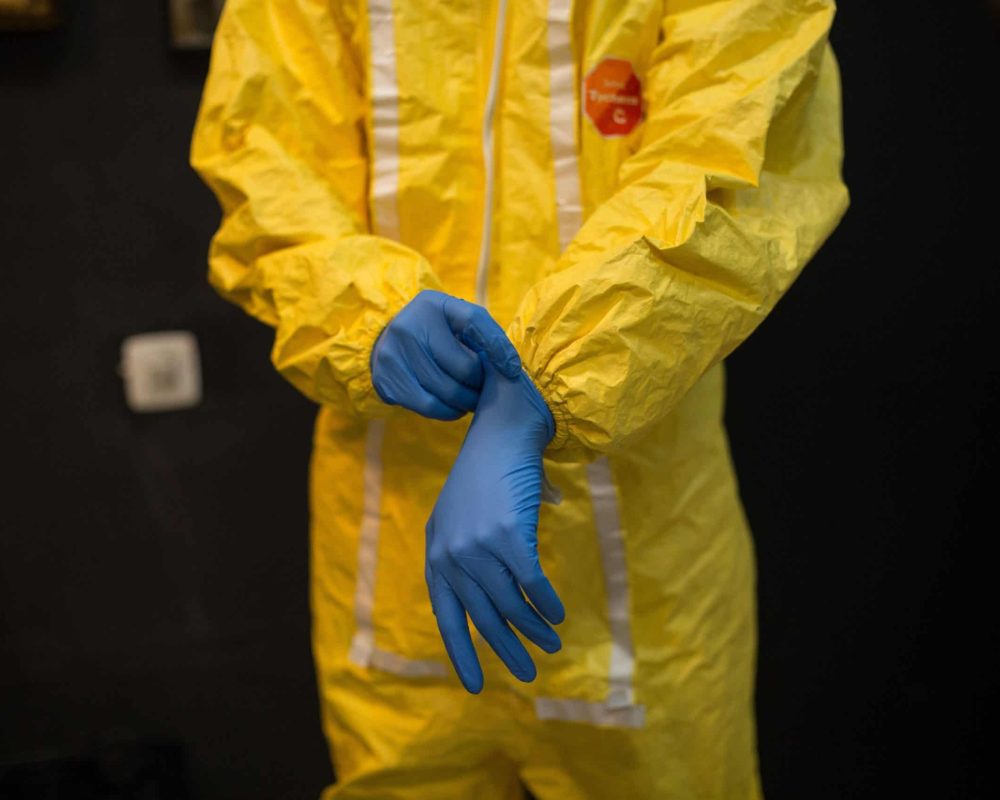Decomposition Death Clean Up: Specialized and Respectful Remediation
Decomposition Death Clean Up: Specialized and Respectful Remediation
Blog Article
Expert Biohazard Cleaning and Decontamination for Blood, Bodily Fluids, and Hazardous Products
The potential health and wellness threats associated with direct exposure to biohazards emphasize the crucial need for precise handling and complete cleanup. As we navigate the detailed landscape of biohazard clean-up, recognizing the nuances of regulations, conformity, and the specialized devices at play becomes imperative in making certain a comprehensive and secure purification process.
Health Dangers of Biohazard Exposure
Exposure to biohazards positions substantial health and wellness threats that can cause severe consequences for individuals and neighborhoods alike. Biohazards include a vast array of organic compounds, consisting of blood, physical liquids, mold and mildew, microorganisms, infections, and various other potentially contagious materials. When individuals come into contact with these biohazards, whether through crashes, inappropriate handling, or ecological direct exposure, they encounter the danger of contracting major diseases or illness.
One of the key health risks related to biohazard exposure is the transmission of transmittable conditions. Bloodborne microorganisms such as HIV, hepatitis B and C, and various bacteria can be existing in biohazardous products, presenting a direct risk to human health. Breathing in air-borne biohazards like mold spores or entering call with polluted surfaces can likewise bring about respiratory system problems, allergies, and various other negative health results.
Moreover, biohazard exposure can have lasting health and wellness implications, with some diseases showing up years after the preliminary contact (Blood Cleanup). Consequently, it is important to prioritize correct biohazard cleaning and purification to alleviate these health threats and guarantee the safety and security of individuals and communities

Specialized Training for Biohazard Cleaning
When it comes to managing biohazard cleaning successfully and safely, specialized training plays an essential function in making certain proper decontamination procedures are adhered to. Biohazard cleaning requires specific understanding and skills to successfully minimize risks associated with bloodborne pathogens, bodily fluids, and harmful products. Specialists learnt biohazard cleaning go through extensive guideline on just how to securely take care of, get rid of, and deal with biohazardous materials to avoid contamination and exposure.
Specialized training for biohazard clean-up covers a series of vital subjects, including appropriate individual protective devices (PPE) use, bloodborne virus recognition, purification strategies, and unsafe waste disposal methods. People learnt biohazard cleanup are geared up with the necessary competence to evaluate contamination levels, identify possible threats, and carry out proper clean-up procedures in conformity with governing requirements.
Continuous training and education are vital in the area of biohazard clean-up to stay upgraded on the most recent decontamination technologies, safety and security procedures, and policies. By buying specialized training, biohazard cleaning experts can properly react to emergency situation cleanup situations and guard both public wellness and the atmosphere.
Relevance of Proper Purification Techniques
Making use of appropriate purification methods is important in biohazard cleanup to successfully reduce and remove unsafe materials wellness dangers. Reliable decontamination not just ensures the elimination of noticeable traces of blood, bodily liquids, and various other biohazards however also targets invisible microorganisms that may present severe health and wellness dangers otherwise effectively gotten rid of. By adhering to strict purification methods, trained specialists can substantially reduce the danger of exposure to dangerous bacteria, viruses, and microorganisms that could cause infections or diseases.
Appropriate decontamination strategies involve making use of customized tools and disinfectants that are specifically developed to counteract biohazards properly. Comprehensive cleaning and sanitation of polluted areas are necessary to prevent the spread of pathogens and ensure a risk-free atmosphere for residents. Furthermore, the right disposal of biohazardous waste adhering to purification treatments is essential in avoiding contamination of other surfaces or individuals.

Equipment and Devices for Safe Cleaning
When dealing with blood, physical liquids, or hazardous products, biohazard cleansing specialists count on specialized gear to decrease exposure dangers and extensively decontaminate the afflicted location. Additionally, biohazard cleansing packages containing disinfectants, absorbing products, and biohazard bags are used to view it now safely consist of and get rid of of contaminated things.
Advanced cleaning devices like hospital-grade anti-bacterials, HEPA-filtered vacuums, and misting equipments are employed to sanitize surfaces and eliminate biohazards successfully. Specialized tools such as sharps containers and biohazard waste disposal bins are utilized to safely handle sharp items and biohazardous waste products. By making use of the appropriate equipment and tools, biohazard cleaning professionals can guarantee a complete cleaning procedure that focuses on safety and minimizes health risks for both workers and occupants of the affected space.
Regulations and Compliance in Biohazard Cleansing
Proper adherence to policies and conformity criteria is extremely important in biohazard cleansing to make sure discover this info here the safety and security of both workers and the atmosphere. Government agencies such as OSHA (Occupational Safety and Health Management) and the EPA (Environmental Security Company) have developed certain standards for biohazard clean-up procedures to decrease wellness dangers and environmental contamination. These regulations cover a series of facets consisting of the handling, transportation, and disposal of biohazardous products, along with the essential training and safety devices required for employees associated with the cleanup procedure.
Biohazard cleansing companies must remain updated with these regulations to assure that their operations meet the called for security standards. Failing to comply with these laws can lead to severe effects, including penalties, legal activity, and threatening the health and wellness of people and the setting. By adhering to strict laws and compliance actions, biohazard cleaning firms can successfully mitigate dangers and ensure a detailed and safe cleanup process for all events entailed.
Verdict
To conclude, biohazard cleaning and purification need specialized training, correct strategies, and adherence to guidelines. Exposure to blood, bodily fluids, and hazardous products positions substantial health and wellness threats, making it essential to use the appropriate devices and devices for secure cleanup. By complying with rigorous methods and guidelines, experts can successfully minimize the dangers related to biohazard direct exposure and make certain the safety of both themselves and others.
As we navigate the complex landscape of biohazard cleaning, recognizing the nuances of regulations, compliance, and the specific devices at play becomes click site imperative in guaranteeing a detailed and secure decontamination process. (Blood Cleanup)
When it comes to dealing with biohazard cleanup efficiently and safely, specialized training plays a fundamental role in guaranteeing proper decontamination procedures are adhered to.Making use of proper purification methods is essential in biohazard clean-up to efficiently eliminate hazardous products and decrease health threats. In addition, biohazard cleansing kits containing anti-bacterials, absorbing products, and biohazard bags are utilized to safely have and get rid of of infected products.
Government firms such as OSHA (Occupational Safety And Security and Health And Wellness Administration) and the EPA (Environmental Defense Company) have developed certain guidelines for biohazard cleaning procedures to minimize wellness dangers and ecological contamination.
Report this page